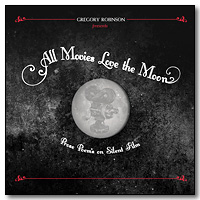All Movies Love the Moon: Prose Poems on Silent Film by Gregory Robinson
All Movies Love the Moon: Prose Poems on Silent Film by Gregory Robinson
Rose Metal Press
Paperback, 96 pages
ISBN: 978-0-9887645-5-2
Gregory Robinson’s innovative collection, All Movies Love the Moon, explores the relationship between text and film through a series of prose poems inspired by the creative geniuses of the silent movie era who used title cards to shape narratives. “She chose the cinema as a medium of self-expression,” reads a title card from Show People (1928), and in this collection Robinson reveals how our understanding of film is mediated by contexts that we take for granted. An experiment in technological ekphrasis and influenced by historical and surrealist fiction, the prose poems take their titles from names of silent movies, most of which are unfamiliar to a contemporary audience. The collection is divided into three parts, The Cinema of Attractions, Narrative Cinema, and The End of Silents, and is organized chronologically, but much like memory transgresses diachronic time, these prose poems skip between the past and present in a playful mingling of worlds.

Silent movies tend to have flexible genre conventions. While we tend to think of images as being infallible, Robinson’s book suggests that the legitimacy of motion pictures was not so rigidly set in its infancy. The first recorded films were nonfiction with purely descriptive titles, such as Thomas Edison’s Record of a Sneeze. As the film industry developed and as technology improved, fictional narratives became more popular, but like the early novel, narrative forms were not fully developed. Without sound, stories were often loose and bewildering to audiences. In the introduction, Robinson claims that you won’t learn anything by reading this book, but the prose poems along with the captions that accompany each title card illuminate film history as much as they creatively interpret it to generate new stories.
The first prose poem imagines a conversation with Ralph Spense, a “film doctor” who “could take unfunny films and make them watchable again just by changing the text.” The title cards made films a legitimate artistic medium and their importance was not lost on filmmakers, who employed film doctors, many who had formerly been newspaper reporters, to give shape to silent movies. As one caption states, “There was a rumor in Hollywood that producers would bring George Marion, Jr. a full movie with all the scenes completed, but they would not know if it was a comedy or a drama until Marion had written the titles.” Such mutability reminds us that the context for a scene matters as much as the content. In our present day, we can imagine a similar effect created by a laugh track or dramatic film score, but this collection chooses to underscore the emotional resonance of film through a sense of nostalgia for text, a thread that connects each of the disparate prose poems.
The development of narrative structures brought with it other trappings of the film industry that are more familiar to us today. Film actors were originally not named, but when studios began to use stars to build a brand, movies became a way for audiences to see themselves in a different life. Silent movies also anticipated product placement by noting that filmmakers used company logos to ensure copyright. While these factoids suggest a steady progression to our modern day, the prose poems often lament the isolating effect of technology. For example, College Chums (1907) features two people typing with the words “Hello darling” linking them, and the caption notes how the development of stop motion allowed text to “fly across cities.” The accompanying prose poem reimagines the couple in a contemporary setting, physical and temporal distance driving them apart: “text messages hurt as we hurled die-cast letters across immense spaces,” like “a pile of unspeakables that collided mid-air and fell.” Similarly, The Sea Hawk (1924) juxtaposes the romantic image of a swashbuckler with “modern pirates.” This prose poem is an ode to present-day “scoundrels,” and the speaker jealously heaps praise “for sleeping in until two, for devoting their days to video games and anime, for partners who find this recalcitrance irresistible.” The caption for the accompanying image notes that the title cards in Hollywood’s biggest film library have been “lost or destroyed,” an unfathomable loss in today’s digital world, where pirates ensure that movies will never disappear because they endlessly reproduce their images. The pairing of these images leaves ambiguous whether this is something to regret or celebrate.
The accompanying prose poem for Show People ironically notes, “It is the life projected rather than the life as is.” A late production in the silent film era, Show People was one of the last to be created after The Jazz Singer (1927) introduced sound to film. The pieces in this collection conjure sepia-tinged fondness for the innovations that define our modern era, none more so than the way texts shape our personal stories.
